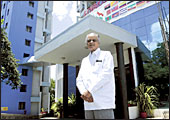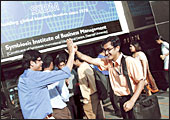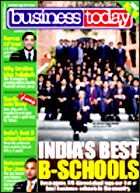 |
SIBM PUNE
Director Arun Mudbidri with faculty members outside the SIBM
building |
Not
very far from the quite unremarkable four-storey building that
houses Symbiosis Institute of Business Management, still inside
the B-school's smallish campus on one end of Pune's Senapati Bapat
Marg, is a life-size statue of cartoonist R.K. Laxman's best-known
character, the Common Man. It seems somehow apt that this, the
epitome of ordinariness, stands as close as it does to the school
which is, at once, both ordinary and extraordinary. It is ordinary
because (let's be honest now), its name isn't just the location,
prefaced by the letters I,I, and M. It is ordinary because it
doesn't have a campus designed by architects as renowned as Louis
Kahn or Balakrishna Doshi. And it is ordinary because it still
(note the word) isn't among the first five or six words that come
out of anyone's mouth when asked to name B-schools: IIM-A, IIM-B,
IIM-C, IIM-L, XLRI, FMS.... It is extraordinary because it has
ranked 6, 5, 8, and 4, in the three preceding editions and the
current one of this magazine's survey of Indian B-schools. It
is extraordinary because its success has engendered, at last count,
five other Symbiosis schools that teach anything from human resources
development to telecommunications management (more on this later).
And it is extraordinary because, late last year, some 78,000 students
sat for snap (Symbiosis National Aptitude test), the admission
test to the various Symbiosis schools (SIBM would be everyone's
first choice); this number compares favourably with the 125,000
that sat for cat (Common Admissions Test), the admission test
to the Indian Institutes of Management (IIMs). Arun Mudbidri,
a Class of 1984 alum and Director of the school, is happy enough
with Symbiosis' achievements to start thinking of a brand-equity
equal to that of the IIMs. "I want to make SIBM top of mind
for prospective students." Already, by one measure at least,
the success of Symbians (as the graduates are known, even though
they hardly use this term anymore) in industry, Symbiosis would
seem to have arrived. Why, in April, Shoppers' Stop, Perfetti
India, and the India Today Group (which publishes Business Today),
announced the appointment of new CEOs (Govind Shrikhande, Prakash
Wakankar, and Ashish Bagga respectively) all within the space
of a few days, and all Symbians.
| FACTFILE: IIM-A |
Founded: 1978
Batch size: 149 (class of 2006) increasing to 300 (class
of 2010)
Faculty: Student ratio: 1:25
Average domestic salary in placements 2006: Rs 7.2
lakh
Average international salary in placements 2006: $85,000
Number of offers made during placements 2006: 191
Number of international offers made during placements 2006:
One
Success rate for applicants: 1:300 (54,000 students
opted for SIBM in the SNAP, 180 made it) |
The Makings Of Greatness
In many ways, the IIMs, at least the big
three among them, the ones at Ahmedabad, Bangalore, and Kolkata,
have it easy. They are established brands, and strong ones, and
are probably the first choice of any student who wants a post
graduate diploma in business management (pgdbm is what the IIMs
offer, not an MBA). The best graduates compete for admission to
these schools, and the few that get in do so after a three-stage
process including a tough test, a group discussion, and an interview.
The gruelling two-year programme sharpens the skills of these
best-of-the-best. And companies vie to hire them. In turn, these
individuals go out to companies and perpetuate the culture and
the brand of the IIMs. So, how does a school like SIBM break into
this elite club?
| WHAT MAKES SIBM TICK |
»
Long serving faculty: Most of SIBM's teachers have
been around for over a decade and many of them are from the
institute
» Great
corporate relations: SIBM's students and faculty go out of
their way to facilitate corporate interaction from weekly
industry reports to even doing projects for no cost
» Unmatched
alumni interaction: The institute holds four annual alumni
meets, but last year increased it to eight, including meets
in Dubai and Singapore, and maintains an extensive alumni
database
» Lots
of extra-curricular activities: Students always have more
than management studies on their minds, and that keeps them
sharp |
The hard way (actually, there would appear
to be no other). Since 1978, when it was founded, SIBM has worked
hard at the things that make a good school: a tough entrance test
(until 2002, this was a test for admission to just SIBM; since
then, the school has moved to snap), a good curriculum (till 2002,
SIBM was under the purview of Pune University, and had to follow
the university's guidelines; in that year, Symbiosis Society was
recognised as a deemed university by the government, allowing
it to set its own curriculum for courses, and conduct snap, a
common test for admission to several Symbiosis institutions),
a vibrant on-campus culture (despite the fact that there isn't
really much of a campus), and good relations with alumni. Last
year, for instance, SIBM organised eight alumni meets, including
one each in Dubai and Singapore, and the school even boasts a
Young Managers Development Programme that helps just-out-of-SIBM
students cope with the first six months on a job. "You'd
be surprised at how effective this is," says Mudbidri. "There
are several reasons (why SIBM is popular with students) but the
two major ones are the strength of our alumni network and the
quality of corporate interaction," adds Shikha Singhania,
a second-year student at the school.
 |
| Talent house: SIBM students sharpen
their skills in a vibrant culture |
The alumni factor is beginning to count now:
it takes an individual between 15 years and 25 years to make a
mark in industry, and Symbiosis is now 28 years old. Several students
from earlier batches are now in senior management positions in
companies, and the school has managed to stay in touch with most.
"The bonds you made back then still hold," says Ravi
Menon, Director, Global Investment Banking, HSBC, and part of
the Class of 1986 (his wife, Tina, is from the same class). "It
(Symbiosis) was a great place to study."
One Brand, Many Schools
Today, Symbiosis Society runs six post-graduate
management institutions. Apart from SIBM, these are Symbiosis
Centre for Management and Human Resource Development (SCHMRD),
Symbiosis Institute of Management Studies (SIMS; this is only
for the children of defence personnel), Symbiosis Institute of
International Business (SLIB), Symbiosis Institute of Telecom
Management (SITM), and Symbiosis Institute of Operations Management
(SIOM).
Most recruiters associate the name Symbiosis
with SIBM, but there are some who do it with the other schools;
even in the BT-ACNielsen ORG-MARG survey, it is likely that most
respondents meant SIBM when they said Symbiosis (which would mean
that of all the Symbiosis schools, SIBM has the first claim to
being the fourth best B-school in the country).
 |
 |
| Umbrella brand: S.B. Majumdar, founder,
Symbiosis Society, wants the family to get even bigger |
Bonding with the best: It's a great
place to study, echo students as their brand equity soars |
"SIBM is the oldest and its alumni are
beginning to do very well and therefore, maybe it does get associated
with the name more," admits S.K. Mujumdar, Founder of the
Symbiosis Society, who see Symbiosis as a sort of umbrella brand.
"Old recruiters know the difference between SIBM and the
rest," says Shloke Churiwal, a second-year student who is
on the placement advisory team, "but there is a level of
confusion, particularly among companies we approach for the first
time."
That doesn't bother either Mudbidri or Mujumdar;
both can't wait for SIBM to move into its new campus, just outside
Pune. "If SIBM has to become a world-class institute, it
needs a residential campus with great infrastructure," says
Mujumdar. "We will expand courses and enter lucrative areas
such as executive development," gushes Mudbidri. And that,
too, will do its bit for the Symbiosis brand.
| THEY WENT TO SIBM |
Ranjan Acharya
Corporate VP, HRD/ Wipro (class of 1980)
Melwyn Rego
MD & CEO/ IDBI Home Finance (1981)
Vikas Phadnis
CEO/ Bell Granito Ceramics (1981)
David Lobo
VP/ GE Consumer Finance (US) (1983)
Bhaskar Menon
President/ Mphasis (1984)
Govind Shrikhande
CEO/ Shoppers' Stop (1984)
|
Prakash Wakankar
CEO/ Perfetti India (1985)
Pradeep Gidwani,
MD/ Red Bull Beverages, Dubai (1986)
Ravi Menon
Director/ GIB - India, HSBC (1986)
Ashwin Deo,
MD/ Moet Hennessy India (1987)
Vivek Chandra
VP, Business Develop./ Tech Mahindra (1991)
Arun Mansukhani
GM, HR/ Hutchison Essar (1993)
|
|







